NOTE March 2015:
A new reverse die (Reverse D) has been identified and another die marriage (BF-5). This is now detailed in the page below, and on the new page for BF-5.
An addendum that can be downloaded, printed, and inserted in the Print Edition is available by clicking the link here:
1875-CC Addendum March 2015, PDF, 2.5mb
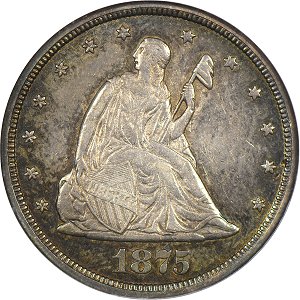
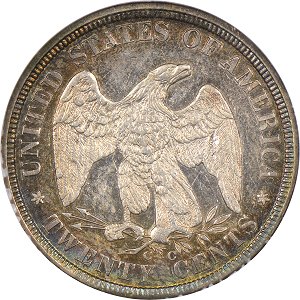
Original Mintage:
Circulation strikes: 133,290
Approximately 2000 or so unreleased pieces were melted at the Carson City Mint during 1877 (along with most of the 1876-CC coins) when it was decided to abolish the circulating
version of this coin. A reasonable estimate of the net mintage of the 1875-CC is approximately 131,000.
Major Varieties:
A minor recut 5 appears in the date on the more common of just two known obverse dies.
Overall Scarcity:
One of the two common dates of the series, this issue is very easily found in lower circulated grades, up to and including VF. Any large coin show will have dozens of them available
in these grades. Coins in XF and AU are available with some searching and a strong premium is attached to attractive, original coins. Mint State coins are also readily available and
generally appear at auction rather than on the bourse floor.
Often touted as scarce or rare, this is really not true as circulated examples in VF and below are easily found. Higher grade examples are becoming more scarce and the availability of
pieces graded EF and above is decreasing.
Large price gains in recent years have brought hundreds of them onto the market so that at a given dealer’s table, you may now find more 1875-CC coins than the more common 1875-S. Part
of the demand for this coin is that it represents the only “CC” twenty-cent piece that most collectors can afford. Soon the availability of the 1875-CC may diminish as more collectors seek an example.
Comments:
The coin generally comes poorly struck, with weakness commonly found on Liberty’s head, the shield and LIBERTY. On the reverse, weakness is often found on the eagle’s head, central breast feathers,
and the top of the wings on the reverse.
Interestingly, the 1875-CC was struck using two different retaining collars, giving the coins two different diameters. The majority of them (struck with the first obverse die) are found with a
diameter of 22.1 mm, whereas those struck with the second obverse die are found with a diameter of only 21.8 mm, a variance of over 1%. If one holds coins stuck from the two different retaining
collars side-by-side between the fingers, the difference is discerned without much difficulty.
Many type collectors who want a single example of the denomination, but don’t want to settle for the more-common 1875-S, will find an 1875-CC an appealing alternative, although at a premium price.
Based on rarity, the 1875-CC is overrated and overpriced in lower and middle grades. The coin has tremendous collector interest as the only collectible twenty-cent piece from the Carson City Mint,
and “CC” coin collectors are a fast-growing and active segment of coin collectors. As mentioned previously, impressive price gains over the last decade have brought large numbers of this date into
the marketplace, most likely duplicates from many collections. The influx of 1875-CC examples in the current market has slowed sales and caused prices to level and even decrease more recently for
lower-grade pieces.
Die Marriages:
Two obverse and four reverse dies were used for this issue. The date and mintmark positions are the easiest way to distinguish the different dies. However, one of the obverse dies has a slightly recut
5 and exhibits several gouges that can be used for identification.
The first of the four reverse dies used, Reverse A, buckled and cracked soon after its use began and was quickly replaced, resulting in a rare die marriage (BF-1). The second reverse, identified in January 2015
(Reverse D), replaced Reverse A. Reverse D also buckled and was apparently replaced after an even shorter duration, resulting in an even rarer die marriage (BF-5). See images below for buckled Reverses A and D.
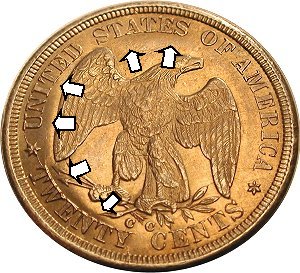
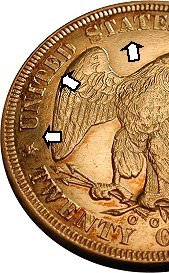
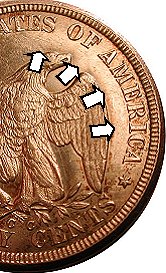
Buckled Reverses A and D with undulating fields
The mintmarks have different spacing between the two letters, with one mintmark being spaced noticeably more apart (wide) than the other three (close). The letters C C also have varying amounts of
tilt in either direction.

Die Marriage Grid for the 1875-CC
Below is a side-by-side comparison of date and mintmark positions provided to illustrate the different dies.
Side-by-side date positions, using the shield point for comparison:
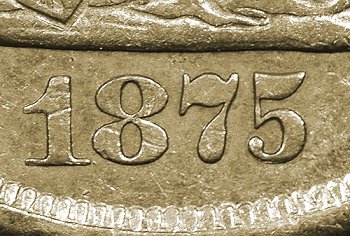 Obverse 1, Date to the left |
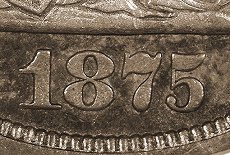 Obverse 2, Date to the right |
Side-by-side mintmark positions:
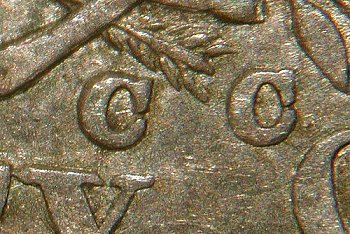 Reverse A, "Low Close CC #1" |
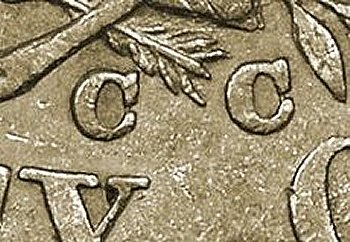 Reverse B, "High Close CC" | |
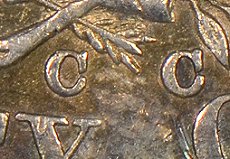 Reverse C, "Wide CC" |
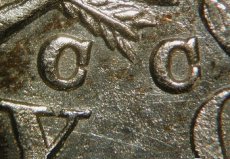 Reverse D, "Low Close CC #2" |
|
